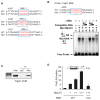Nkx2-5 Regulates Tdgf1 (Cripto) Early During Cardiac Development
- PMID: 24069547
- PMCID: PMC3779917
- DOI: 10.4172/2155-9880.S11-003
Nkx2-5 Regulates Tdgf1 (Cripto) Early During Cardiac Development
Abstract
Congenital Heart Disease (CHD) is the most frequent and deadly birth defect. Patients with CHD that survive the neonatal period often progress to develop advanced heart failure requiring specialized treatment including cardiac transplantation. A full understanding of the transcriptional networks that direct cardiac progenitors during heart development will enhance our understanding of both normal cardiac function and pathological states. These findings will also have important applications for emerging therapies and the treatment of congenital heart disease. Furthermore, a number of shared transcriptional pathways or networks have been proposed to regulate the development and regeneration of tissues such as the heart. We have utilized transgenic technology to isolate and characterize cardiac progenitor cells from the developing mouse heart and have begun to define specific transcriptional networks of cardiovascular development. Initial studies identified Tdgf1 as a potential target of Nkx2-5. To mechanistically dissect the regulation of this molecular program, we utilized an array of molecular biological techniques to confirm that Nkx2-5 is an upstream regulator of the Tdgf1 gene in early cardiac development. These studies further define Nkx2-5 mediated transcriptional networks and enhance our understanding of cardiac morphogenesis.
Keywords: Cardiogenesis; Mouse; Nkx2-5; Tdgf1.
Figures



References
-
- Hoffman JI. Incidence of congenital heart disease: II. Prenatal incidence. Pediatr Cardiol. 1995;16:155–165. - PubMed
-
- Olson EN, Srivastava D. Molecular pathways controlling heart development. Science. 1996;272:671–676. - PubMed
-
- Fishman MC, Olson EN. Parsing the heart: genetic modules for organ assembly. Cell. 1997;91:153–156. - PubMed
-
- Harvey RP. Patterning the vertebrate heart. Nat Rev Genet. 2002;3:544–556. - PubMed
-
- Olson EN, Schneider MD. Sizing up the heart: development redux in disease. Genes Dev. 2003;17:1937–1956. - PubMed
Grants and funding
LinkOut - more resources
Full Text Sources
Other Literature Sources
